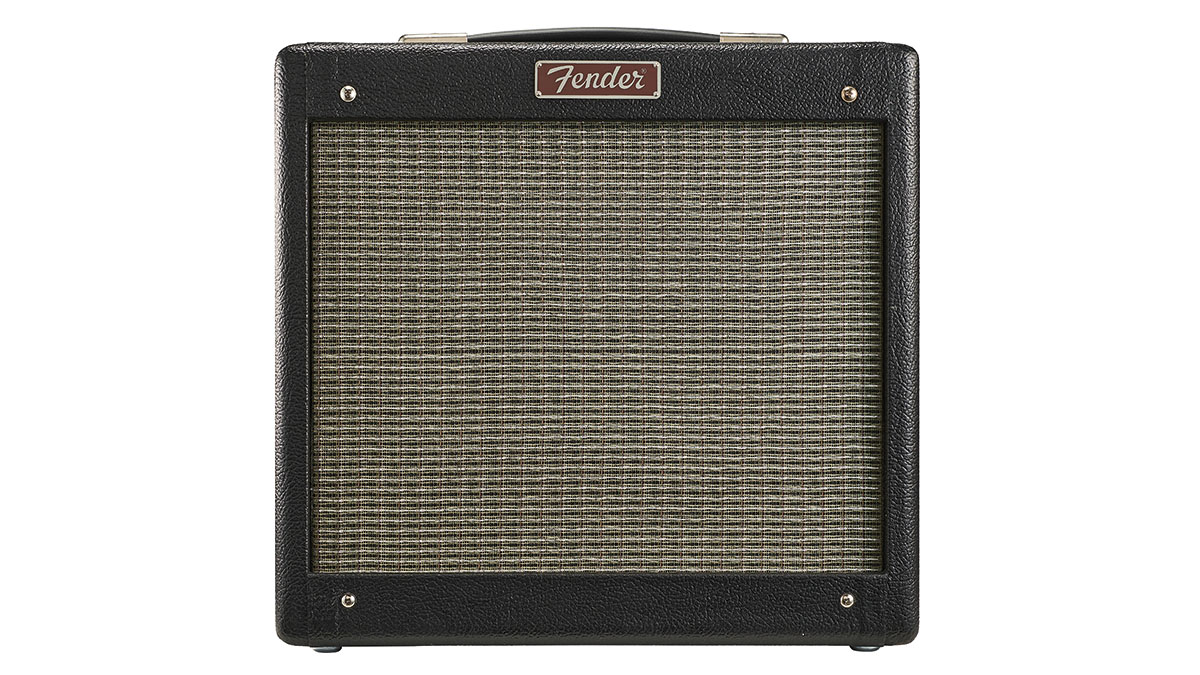Guitar World Verdict
This is a highly usable all-tube Fender amp at a price that’s way more affordable than you might expect – it’s a great fit for everyone from beginners seeking their first tube amp to pro-level pedalboard users.
Pros
- +
Good-looking.
- +
Portable.
- +
Affordable.
- +
Wide range of tone from deceptively simple control layout.
- +
Uprated circuit boards.
Cons
- -
An adjustable bias might be a helpful change, as would a standby function, easily accomplished with a three-way single toggle switch.
You can trust Guitar World
Fender’s highly popular Pro Junior was an instant hit when it was launched back in 1993 and continues to be a favourite secret weapon for many top artists, regularly found hiding behind walls of 100-watt 4x12 stacks at live shows.
We often talk about the classic tweed and black-panel designs dating back to the 1950s and ’60s. However, the Pro and Blues amps from the early ’90s are largely unaltered and still in production today, making them possibly the longest-running in Fender’s history.
The latest Mark IV core version of the Pro Junior features lacquered tweed and a Jensen P10R Alnico speaker, which looks and sounds great – but it has pushed up the price somewhat, hence the welcome arrival of the limited-edition SE version we’re looking at here. We like it so much that it's one of the top picks in our guide to the best tube amps under $500.
No relation to Fender’s original 6L6- powered Pro amps, the Pro Junior SE is a compact all-tube, solid-state rectified 1x10 combo, using a pair of 12AX7s in the preamp and a pair of grid-biased Groove Tubes EL84s in the output stage, driving a Fender Special Design loudspeaker.

Unlike some small combos where the speaker is wired directly into the chassis, the Pro Junior SE connects via a jack plug and socket, so you can unplug the speaker and use an external cabinet if needed.
The cabinet’s styling blends a narrow-panel tweed-era enclosure with black Tolex and a lightly-aged silver sparkle grille cloth for a pleasing visual effect. Under the vinyl you’ll find particle board rather than plywood, which adds a little extra weight, although the combo is still just 10kg, so it’s very easy to lift and carry.

The robust steel tray chassis supports generously sized mains and output transformers and is bolted to the cabinet top and sides, with the top chassis edge forming the control panel.
All the latest guitar news, interviews, lessons, reviews, deals and more, direct to your inbox!
Inside, the components are mounted on two printed circuit boards: a large one for all the preamp, power amp and power supply stuff and a small strip of PCB supporting the downward-pointing valve bases, joined to the main board by four ribbon cables.
The board and component quality is much improved compared with some earlier models; quality resistors and capacitors are held firmly on through-plated PCBs.

As to the controls, they couldn’t be much simpler: a single input jack feeding a pair of black chickenhead knobs for volume and tone on a chrome panel, with a single on/off power switch and Fender’s trademark jewel power indicator, which now uses an LED instead of a filament bulb. The lens can’t be unscrewed on this part, so you can have any colour you like as long as it’s red.
The volume and tone circuits have been tweaked to make them more useful, with a wider range at lower volumes and a more balanced bass response as the volume goes up. Overall, the Pro Junior SE is a good-looking, well-made small amp that’s built to survive live gigs as well as home practice and recording sessions.
Feel & Sounds
We tried out the Pro Junior SE with our regular Strat and a Les Paul loaded with a pair of old PAF humbuckers, which together cover a wide range of familiar sounds. The amp comes to life with practically zero hiss and hum, potentially making it a great platform for effects users.
With a Les Paul plugged in, the signal stays more or less clean until the volume control’s halfway mark is reached, slightly more with the lower-output single coils of a Strat.
Push the volume knob beyond this and while things don’t get much louder, they get a lot wilder as the Pro Junior SE begins to distort in a very pleasing way, beginning with a mild edge that’s great for jazz and country and morphing into a really satisfying tweed/early Marshall crunch ideal for blues and classic rock.

The revised volume control has a more gradual change from clean to overdrive, making the amp much easier to dial in, with less of the fuzzbox-flavoured bass at full power.
The tone control seems to like staying at around the 12 o’clock position, which is a good starting point for any guitar you feel like plugging into the single jack socket, tweaking it clockwise to enhance single-coil snap and brighten up humbuckers, or anti-clockwise to add woody jazz warmth to your archtop.
Midrange and bass are both nicely balanced, too. Our Les Paul sounded great, picking out Jeff Beck and Billy Gibbons-inspired tones with ease. Meanwhile, the lower-powered pickups in our Strat came to life with a little help from a self-built Jeds Peds D-style overdrive pedal, which worked really well with the amp, adding clean/crunch/lead flexibility.
The Pro Junior’s overdrive characteristics are somewhat different from the classic 6V6-powered Fenders, with less midrange and a punchier fixed bias dynamic response, which works really nicely with the 10-inch Fender Special Design loudspeaker.
This is partly down to the EL84’s high-gain characteristics. It’s interesting to see how this European small pentode tube (basically a lower-powered version of the EL34) has been Americanised over the past half a century, becoming a popular choice in many USA mid-powered amps, from budget models such as the Pro Junior up to high-end hand-wired boutique designs costing many thousands of pounds.
We should point out in passing that the Pro Junior SE’s output tube bias is fixed and non-adjustable – accordingly, it’s a good idea not to stray from the factory-fitted valve rating.

As you might expect, there’s no USB or speaker emulation output here, so for serious recording or stage use a good microphone or two will come in handy. We tend to reach for Sennheiser’s excellent MD 421 with this kind of amp in the studio, where this particular mic’s bass roll-off switch and the slightly squeezed frequency range of the 10-inch loudspeaker need very little extra EQ treatment to produce a great range of tones.
For live use, the Pro Junior SE will surprise you – there’s more than enough volume to handle smaller unmic’d pub venues. Although if you need lots of clean headroom a little help from the PA may be needed.
Verdict
Amp technology continues to grow and evolve, with digital power adding the kind of flexibility that would have needed several expensive studio outboards just a few years ago. Yet in spite of these advances, there’s always going to be a need for real tube tone that’s affordable and portable.
Many people equate tubes with expense, so to find that you can still buy a proper all‑valve Fender in the Pro Junior IV SE for under $600 is a bit of an eye-opener.
While the speaker lacks some of the P10R’s harmonic complexity and sparkle, it still sounds great and can always be upgraded if you feel the need
This amp should tick all the boxes for many players, from beginners looking for a first amp that they can keep and grow with, to demanding professional guitarists. You can slot it into the tiniest space on the smallest of stages, while the low noise performance is great news for pedal users and studios.
The upgraded circuit boards – a long overdue improvement – will transform the amp’s longterm reliability, and while the speaker lacks some of the P10R’s harmonic complexity and sparkle, it still sounds great and can always be upgraded if you feel the need.
- Fender Pro Junior vs Blues Junior: which should you buy?
Specs
- PRICE: $549 / £399
- ORIGIN: Mexico
- TYPE: Tube preamp, tube power amp
- OUTPUT: 15W RMS
- TUBES: 2x 12AX7, 2x EL84
- DIMENSIONS: 388 (w) x 222 (d) x 368mm (h)
- WEIGHT (kg/lb): 10.3/23
- CABINET: Particle board
- LOUDSPEAKERS: 1x10” Fender Special Design
- CHANNELS: 1
- CONTROLS: Volume, Tone
- FOOTSWITCH: None
- ADDITIONAL FEATURES: None
- OPTIONS: None
- RANGE OPTIONS: Tweed-covered Jensen P10R-equipped Pro Junior IV combo (£569)
- CONTACT: Fender
Nick Guppy was Guitarist magazine's amp guru for over 20 years. He built his first valve amplifier at the age of 12 and bought, sold and restored many more, with a particular interest in Vox, Selmer, Orange and tweed-era Fenders, alongside Riveras and Mark Series Boogies. When wielding a guitar instead of soldering iron, he enjoyed a diverse musical career playing all over the UK, including occasional stints with theatre groups, orchestras and big bands as well as power trios and tributes. He passed away suddenly in April 2024, leaving a legacy of amplifier wisdom behind him.


